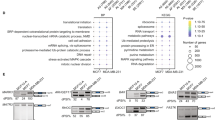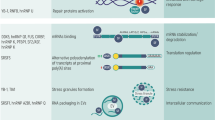Abstract
Alternative splicing of pre-mRNA increases the diversity of protein functions. Here we show that about half of all active alternative splicing events in ovarian and breast tissues are changed in tumors, and many seem to be regulated by a single factor; sequence analysis revealed binding sites for the RNA binding protein FOX2 downstream of one-third of the exons skipped in cancer. High-resolution analysis of FOX2 binding sites defined the precise positions relative to alternative exons at which the protein may function as either a silencer or an enhancer. Most of the identified targets were shifted in the same direction by FOX2 depletion in cell lines as they were in breast and ovarian cancer tissues. Notably, we found expression of FOX2 itself is downregulated in ovarian cancer and its splicing is altered in breast cancer samples. These results suggest that the decreased expression of FOX2 in cancer tissues modulates splicing and controls proliferation.
This is a preview of subscription content, access via your institution
Access options
Subscribe to this journal
Receive 12 print issues and online access
$189.00 per year
only $15.75 per issue
Buy this article
- Purchase on Springer Link
- Instant access to full article PDF
Prices may be subject to local taxes which are calculated during checkout





Similar content being viewed by others
References
Wang, E.T. et al. Alternative isoform regulation in human tissue transcriptomes. Nature 456, 470–476 (2008).
Pan, Q., Shai, O., Lee, L.J., Frey, B.J. & Blencowe, B.J. Deep surveying of alternative splicing complexity in the human transcriptome by high-throughput sequencing. Nat. Genet. 40, 1413–1415 (2008).
Balzer, R.J. & Henry, M.F. Snu56p is required for Mer1p-activated meiotic splicing. Mol. Cell. Biol. 28, 2497–2508 (2008).
Lynch, K.W. & Maniatis, T. Assembly of specific SR protein complexes on distinct regulatory elements of the Drosophila doublesex splicing enhancer. Genes Dev. 10, 2089–2101 (1996).
Xu, X. et al. ASF/SF2-regulated CaMKIIδ alternative splicing temporally reprograms excitation-contraction coupling in cardiac muscle. Cell 120, 59–72 (2005).
Licatalosi, D.D. et al. HITS-CLIP yields genome-wide insights into brain alternative RNA processing. Nature 456, 464–469 (2008).
Tazi, J., Bakkour, N. & Stamm, S. Alternative splicing and disease. Biochim. Biophys. Acta 1792, 14–26 (2009).
Christofk, H.R. et al. The M2 splice isoform of pyruvate kinase is important for cancer metabolism and tumour growth. Nature 452, 230–233 (2008).
Klinck, R. et al. Multiple alternative splicing markers for ovarian cancer. Cancer Res. 68, 657–663 (2008).
Venables, J.P. et al. Identification of alternative splicing markers for breast cancer. Cancer Res. 68, 9525–9531 (2008).
Venables, J.P. Aberrant and alternative splicing in cancer. Cancer Res. 64, 7647–7654 (2004).
Martinez-Contreras, R. et al. hnRNP proteins and splicing control. Adv. Exp. Med. Biol. 623, 123–147 (2007).
Singh, R. & Valcarcel, J. Building specificity with nonspecific RNA-binding proteins. Nat. Struct. Mol. Biol. 12, 645–653 (2005).
Ule, J. et al. An RNA map predicting Nova-dependent splicing regulation. Nature 444, 580–586 (2006).
Ponthier, J.L. et al. Fox-2 splicing factor binds to a conserved intron motif to promote inclusion of protein 4.1R alternative exon 16. J. Biol. Chem. 281, 12468–12474 (2006).
Grosso, A.R., Martins, S. & Carmo-Fonseca, M. The emerging role of splicing factors in cancer. EMBO Rep. 9, 1087–1093 (2008).
Ghigna, C. et al. Cell motility is controlled by SF2/ASF through alternative splicing of the Ron protooncogene. Mol. Cell 20, 881–890 (2005).
Karni, R. et al. The gene encoding the splicing factor SF2/ASF is a proto-oncogene. Nat. Struct. Mol. Biol. 14, 185–193 (2007).
Cheung, H.C. et al. Global analysis of aberrant pre-mRNA splicing in glioblastoma using exon expression arrays. BMC Genomics 9, 216 (2008).
Gardina, P.J. et al. Alternative splicing and differential gene expression in colon cancer detected by a whole genome exon array. BMC Genomics 7, 325 (2006).
Thorsen, K. et al. Alternative splicing in colon, bladder, and prostate cancer identified by exon array analysis. Mol. Cell. Proteomics 7, 1214–1224 (2008).
Xi, L. et al. Whole genome exon arrays identify differential expression of alternatively spliced, cancer-related genes in lung cancer. Nucleic Acids Res. 36, 6535–6547 (2008).
Zhang, C. et al. Defining the regulatory network of the tissue-specific splicing factors Fox-1 and Fox-2. Genes Dev. 22, 2550–2563 (2008).
Yeo, G.W. et al. An RNA code for the FOX2 splicing regulator revealed by mapping RNA-protein interactions in stem cells. Nat. Struct. Mol. Biol. 16, 130–137 (2009).
Kornblihtt, A.R., Vibe-Pedersen, K. & Baralle, F.E. Human fibronectin: molecular cloning evidence for two mRNA species differing by an internal segment coding for a structural domain. EMBO J. 3, 221–226 (1984).
Li, H. et al. Determination of tag density required for digital transcriptome analysis: application to an androgen-sensitive prostate cancer model. Proc. Natl. Acad. Sci. USA 105, 20179–20184 (2008).
Castle, J.C. et al. Expression of 24,426 human alternative splicing events and predicted cis regulation in 48 tissues and cell lines. Nat. Genet. 40, 1416–1425 (2008).
Pruitt, K.D., Tatusova, T., Klimke, W. & Maglott, D.R. NCBI Reference Sequences: current status, policy and new initiatives. Nucleic Acids Res. 37, D32–D36 (2009).
Fan, W. et al. BRCA1 regulates GADD45 through its interactions with the OCT-1 and CAAT motifs. J. Biol. Chem. 277, 8061–8067 (2002).
Venables, J.P. Downstream intronic splicing enhancers. FEBS Lett. 581, 4127–4131 (2007).
Venables, J.P. et al. Multiple and specific mRNA processing targets for the major human hnRNP proteins. Mol. Cell. Biol. 28, 6033–6043 (2008).
Thierry-Mieg, D. & Thierry-Mieg, J. AceView: a comprehensive cDNA-supported gene and transcripts annotation. Genome Biol. 7, S12 (2006).
Jin, Y. et al. A vertebrate RNA-binding protein Fox-1 regulates tissue-specific splicing via the pentanucleotide GCAUG. EMBO J. 22, 905–912 (2003).
Underwood, J.G., Boutz, P.L., Dougherty, J.D., Stoilov, P. & Black, D.L. Homologues of the Caenorhabditis elegans Fox-1 protein are neuronal splicing regulators in mammals. Mol. Cell. Biol. 25, 10005–10016 (2005).
Ge, X. et al. Interpreting expression profiles of cancers by genome-wide survey of breadth of expression in normal tissues. Genomics 86, 127–141 (2005).
Pontén, F., Jirstrom, K. & Uhlen, M. The Human Protein Atlas—a tool for pathology. J. Pathol. 216, 387–393 (2008).
Fukumura, K. et al. Tissue-specific splicing regulator Fox-1 induces exon skipping by interfering E complex formation on the downstream intron of human F1γ gene. Nucleic Acids Res. 35, 5303–5311 (2007).
Baraniak, A.P., Chen, J.R. & Garcia-Blanco, M.A. Fox-2 mediates epithelial cell-specific fibroblast growth factor receptor 2 exon choice. Mol. Cell. Biol. 26, 1209–1222 (2006).
Calarco, J.A. et al. Global analysis of alternative splicing differences between humans and chimpanzees. Genes Dev. 21, 2963–2975 (2007).
Chisa, J.L. & Burke, D.T. Mammalian mRNA splice-isoform selection is tightly controlled. Genetics 175, 1079–1087 (2007).
Aerbajinai, W., Ishihara, T., Arahata, K. & Tsukahara, T. Increased expression level of the splicing variant of SIP1 in motor neuron diseases. Int. J. Biochem. Cell Biol. 34, 699–707 (2002).
Misao, R., Nakanishi, Y., Fujimoto, J. & Tamaya, T. Expression of sex hormone-binding globulin exon VII splicing variant messenger RNA in human uterine endometrial cancers. Cancer Res. 57, 5579–5583 (1997).
Kim, E., Goren, A. & Ast, G. Insights into the connection between cancer and alternative splicing. Trends Genet. 24, 7–10 (2008).
Roy, M., Xu, Q. & Lee, C. Evidence that public database records for many cancer-associated genes reflect a splice form found in tumors and lack normal splice forms. Nucleic Acids Res. 33, 5026–5033 (2005).
Harper, S.J. & Bates, D.O. VEGF-A splicing: the key to anti-angiogenic therapeutics? Nat. Rev. Cancer 8, 880–887 (2008).
Philippar, U. et al. A Mena invasion isoform potentiates EGF-induced carcinoma cell invasion and metastasis. Dev. Cell 15, 813–828 (2008).
Das, D. et al. A correlation with exon expression approach to identify cis-regulatory elements for tissue-specific alternative splicing. Nucleic Acids Res. 35, 4845–4857 (2007).
Radisky, D.C. et al. Rac1b and reactive oxygen species mediate MMP-3-induced EMT and genomic instability. Nature 436, 123–127 (2005).
Coulter, L.R., Landree, M.A. & Cooper, T.A. Identification of a new class of exonic splicing enhancers by in vivo selection. Mol. Cell. Biol. 17, 2143–2150 (1997).
Yeo, G.W., Nostrand, E.L. & Liang, T.Y. Discovery and analysis of evolutionarily conserved intronic splicing regulatory elements. PLoS Genet. 3, e85 (2007).
Minovitsky, S., Gee, S.L., Schokrpur, S., Dubchak, I. & Conboy, J.G. The splicing regulatory element, UGCAUG, is phylogenetically and spatially conserved in introns that flank tissue-specific alternative exons. Nucleic Acids Res. 33, 714–724 (2005).
Sugnet, C.W. et al. Unusual intron conservation near tissue-regulated exons found by splicing microarrays. PLOS Comput. Biol. 2, e4 (2006).
Norris, J.D., Fan, D., Sherk, A. & McDonnell, D.P. A negative coregulator for the human ER. Mol. Endocrinol. 16, 459–468 (2002).
Baklouti, F. Dual functions of oncogenes in transcription and pre-mRNA spliciing regulation. in Alternative Splicing in Cancer (ed. Venables, J.P.) 235–252 (Transworld Research Network, Trivandrum, India, 2006).
Reyal, F. et al. A comprehensive analysis of prognostic signatures reveals the high predictive capacity of the proliferation, immune response and RNA splicing modules in breast cancer. Breast Cancer Res. 10, R93 (2008).
Mauger, D.M., Lin, C. & Garcia-Blanco, M.A. hnRNP H and hnRNP F complex with Fox2 to silence fibroblast growth factor receptor 2 exon IIIc. Mol. Cell. Biol. 28, 5403–5419 (2008).
Kuroyanagi, H., Ohno, G., Mitani, S. & Hagiwara, M. The Fox-1 family and SUP-12 coordinately regulate tissue-specific alternative splicing in vivo . Mol. Cell. Biol. 27, 8612–8621 (2007).
Bailey, T.L. Discovering novel sequence motifs with MEME. Curr. Protoc. Bioinformatics Unit 2.4 (2002).
Lim, L.P. & Burge, C.B. A computational analysis of sequence features involved in recognition of short introns. Proc. Natl. Acad. Sci. USA 98, 11193–11198 (2001).
Hellemans, J., Mortier, G., De Paepe, A., Speleman, F. & Vandesompele, J. qBase relative quantification framework and software for management and automated analysis of real-time quantitative PCR data. Genome Biol. 8, R19 (2007).
Acknowledgements
Thanks to D. Namroud, C. Richard and M. Lévesque for administrative support. Thanks also to J.-P. Brosseau, B. Bell and H. Nwilati for comments on the manuscript. This work was funded by a grant from Genome Canada and Génome Québec. B.C. is supported by a Canada Research Chair in Functional Genomics. S.A.E. is supported by the Fonds de la Recherche en Santé du Québec (FRSQ) Chercheur National program. Tumor banking was supported by the Banque de tissus et de données of the Réseau de Recherche sur le Cancer of the FRSQ.
Author information
Authors and Affiliations
Contributions
J.P.V., R.K., P.P., B.C. and S.A.E. designed experiments, analyzed data and participated in the writing of the paper; K.T. designed and supervised experiments; C.R. selected and provided tissues; A.B., L.I., M.D., S.C., U.F. and E.L. carried out experiments; C.K., J.G.-B., J.-F.L. and P.T. analyzed data.
Corresponding author
Supplementary information
Supplementary Text and Figures
Supplementary Figures 1–9 and Supplementary Tables 1 and 3 (PDF 2599 kb)
Supplementary Table 2
Excel file (XLS 1169 kb)
Rights and permissions
About this article
Cite this article
Venables, J., Klinck, R., Koh, C. et al. Cancer-associated regulation of alternative splicing. Nat Struct Mol Biol 16, 670–676 (2009). https://doi.org/10.1038/nsmb.1608
Received:
Accepted:
Published:
Issue Date:
DOI: https://doi.org/10.1038/nsmb.1608
This article is cited by
-
RBFOX2 deregulation promotes pancreatic cancer progression and metastasis through alternative splicing
Nature Communications (2023)
-
NRF2 has a splicing regulatory function involving the survival of motor neuron (SMN) in non-small cell lung cancer
Oncogene (2023)
-
Hypoxia-induced alternative splicing in human diseases: the pledge, the turn, and the prestige
Cellular and Molecular Life Sciences (2021)
-
The HNRNPA2B1–MST1R–Akt axis contributes to epithelial-to-mesenchymal transition in head and neck cancer
Laboratory Investigation (2020)
-
Specific inhibition of splicing factor activity by decoy RNA oligonucleotides
Nature Communications (2019)



